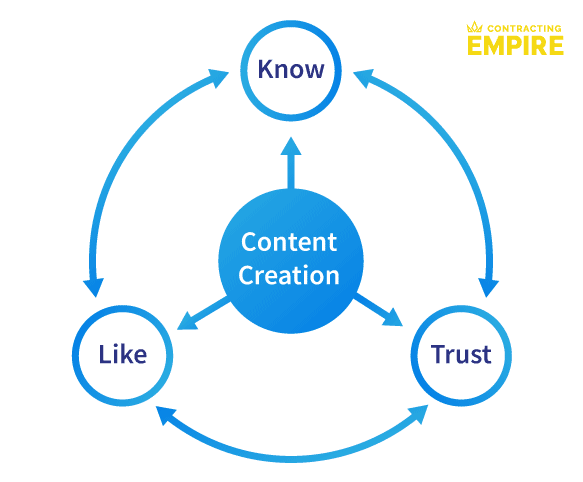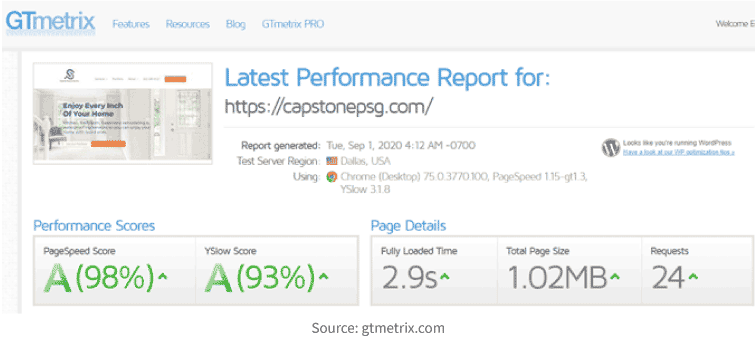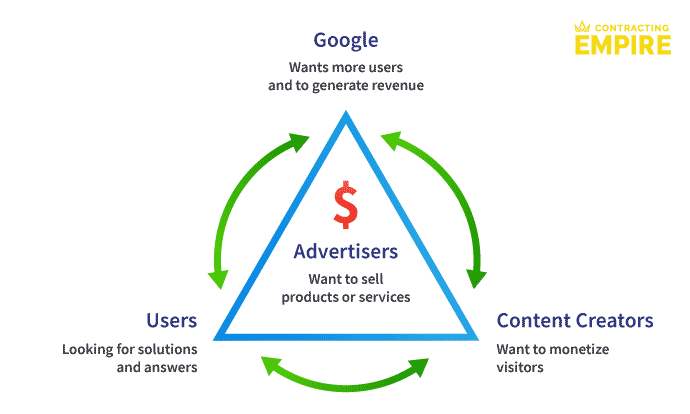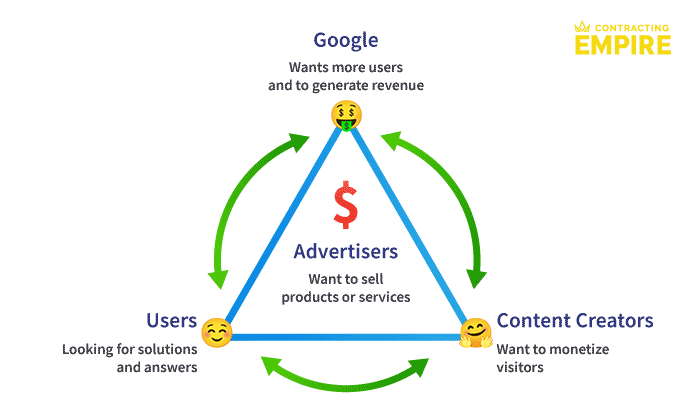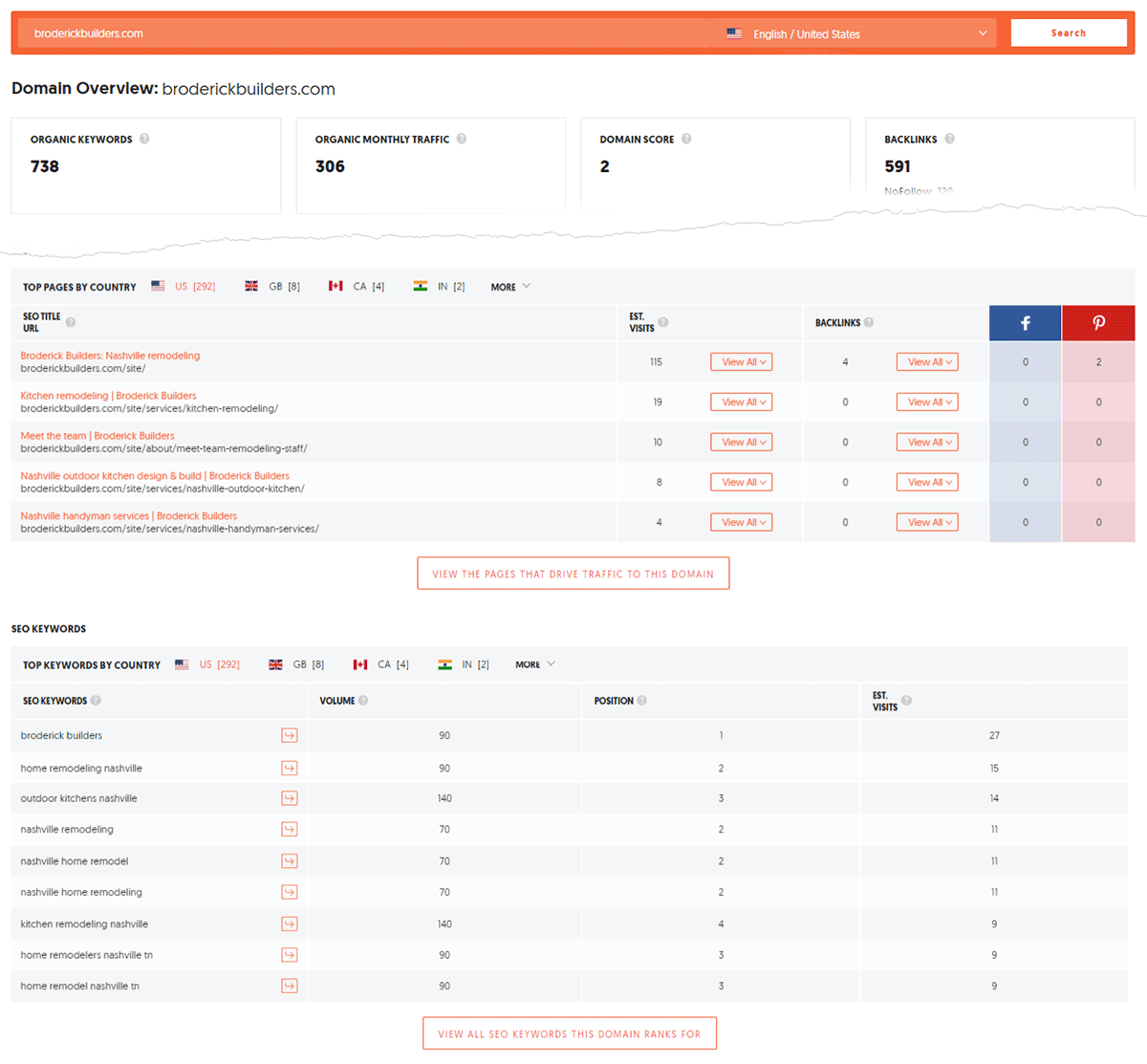SEO For Contractors
Let me start off by saying that this is not your regular SEO for contractors guide.
It’s more like a mini-course that will blow your mind. The course is timeless and the concepts presented will work 10 years from now too.
You don’t want to skip this one.
The potential for your contracting business to grow online is huuuuge. And when I mean growth… I’m talking about a systematic approach to SEO. From creating trust & authority with your visitors to dominating the search engine results.

Think of SEO as a game of chess, where you control both your pieces and those of your adversary. Or your opponent does.
When you do a search online, 99% of the users don’t go past page 1 of the search results. In a recent study by one of the top SEO guys, Brian Dean, the first result gets ~31.7% of the clicks. The first 5 positions get around 90% of all clicks.
That’s where you deserve to be.
But the space is limited. There are only 10 top spots. So it’s either you on one of those top spots or your competitor. If you move up the ranks, you’ll be pushing your competitor down. And vice-versa.
In our recent study of 10,112 contracting websites… it was shocking to learn that over 70.4% of the sites have under 20 visitors per month. It’s like they don’t even exist. 7,119 sites are irrelevant in the eyes of search engines, in the eyes of potential clients.
Only 12.87% of the studied websites have over 100 monthly visitors. We can safely assume that 87.12% of the contractors that are out there don’t have an online business.

What a waste for some, what an opportunity for you!
Gurus tend to paint this whole marketing ordeal as something untouchable & complicated. Something that you can only achieve by buying their course. Outdated tactics that they themselves can’t get to work.
So why should pay attention to me if I’m not a guru?

In 14 years of working online, I got the opportunity to serve some high profile clients. Mostly outside of the contracting space.
People tell me that I’m a leader, a great teacher, coach & mentor.
I worked on hundreds of websites in my lifetime and managed a lot of people. From content writers, programmers, to designers and marketers.
You can read the extensive case study of a manufacturing company that we’re helping in 2020. We were able to get them 6000 unique visitors per month in only 7 months. Consistently.
We also increased their conversion rate. Injected some marketing into what they were already doing. Read the complete case study here.
Jay Abraham is one of the greatest strategists and marketers in the world. He’s also referred to the 21.7 Billion Dollar Man. He is able to actually leverage the 1000+ different industries he served in. Take concepts from one area and apply them to another area and create a new thing. With completely different thinking.
Changes in the field are never produced by experts. But from outsiders looking in at the field.
Dr. Russell Ackoff
This is exactly what I’m doing right now. With all this knowledge I created Contracting Empire, which is like an agency but better.
We don’t just build websites. Do SEO and marketing for contractors. We also help you understand why you’re doing some of the things that you are doing. How does marketing impact your business as a complete system?
That’s what I do best: give you an edge that creates certainty in your business.
Why should you bother with SEO in your contracting business?
That’s a great question. To begin with, when we talk about SEO we’re not really talking about SEO…
SEO stands for search engine optimization. But I would like to reframe SEO and refer to it as a subsystem in your contracting business. Focused on customer happiness & experience. Everything you’re doing online & offline has something to do with the customers’ experience.

For example…
You show up at the door of a potential customer. You’re badly shaven, you stink of booze and your shirt is all dirty and ragged. What kind of image would that create?
Not a positive one, right?
Your appearance would create instant distrust. The owner of the house is probably not even going to open the door for you…
Different scenario – The house owner opens the doors and sees a well-groomed and cleanly dressed man. Your clothes bear your company logo. Your truck is clean. You smile and everything about you shouts professionalism. You’re a PRO.
We’re looking at two very different customer experiences.
The pre-experience, the opinion that they are going to have about you – is going to impact the interaction. After a positive pre-experience, they are going to be much more trusting in what you have to say.
So that’s exactly what you’re doing in the online world too.
First, you need a website. One that’s focused on creating and building trust and authority with your visitors.
Second, add quality SEO content. What does quality SEO content mean? Simply put, it’s the stuff that people are already looking for.
Always enter the conversation already occurring in the prospect's mind.
Robert Collier
Having a professional website that delivers value for your customers. This builds the trust and connection you need in your business.
What you’re getting out of this SEO for Contractors mini-course
I’m going to go in-depth into SEO and what it means for your contracting business.
Going from WHY you should do it:
- Why you need SEO in your contracting business?
- What’s in it for the search engines and why are they helping you?
- Why creating a connection with your customers is important and what’s in it for you.
… to exactly WHAT you’re doing
- What is the visitor’s role in your business ecosystem?
- What should you be doing?
- What is important to track in your marketing efforts?
… and HOW to do it.
- How to actually do the things you need to do.
- How you should be creating your content.
- How to measure and improve your SEO work and keep growing your business.
And a lot more interconnected topics.
We’ll be focusing not only on creating the perfect content leveraging the strategy of preeminence… We’ll also infuse systems thinking into the process.
This mini-course will give you the keys to do the whole process.
At the same time you’re always paying for things in life in either of these two ways:
- With your time;
- With your money.
In case time matters to you more than money at this stage in your business, I’ll also show you how Contracting Empire can help you achieve your SEO goals. How you should be delegating SEO if you don’t want to do it yourself.
Let’s dive in.
Know, Like & Trust. The real things you should be focusing on
Why?
There’s only one main variable that Google looks at:
Does the content on your website provide value for the end-user that clicked on the search result?
Google has thousands of ranking factors. We’ll never know how the actual algorithm works.
Or at least, not anymore…
In the past, people figured out how search engines think. So they abused this knowledge. They ran a whole bunch of traffic to their websites and did shady things. Lots of people got very rich by leveraging these loopholes in Google’s algorithm.
But things have changed.
Google’s algorithm is much much smarter nowadays than it was back in 2005.
It now knows semantic search. It understands what your content is about and what you actually put on your site. It’s definitely not stupid anymore.
Nowadays Google combines artificial intelligence and thousands of ranking factors. They can foretell if your content is something that the users are searching for. This is their end goal.
“SEO for contractors” is going to make your life easier. Because we’re not only talking about SEO as a technical thing you do. We’re talking about the customer experience you’re creating with it.
At one point your referrals are going to run out and you know it. Those damn ads get more and more expensive as more people join the online game. It gets hopeless fast. For 90% of the contracting businesses.
The good news is this…
Once you invest in creating great content that people are looking for – Google is going to show you in the top positions.

When you invest in a quality website and create quality SEO content, the system will bring in qualified leads. Without you having to ever pay for them again.
Why Google?
At the time of writing, Google is the biggest search engine out there.
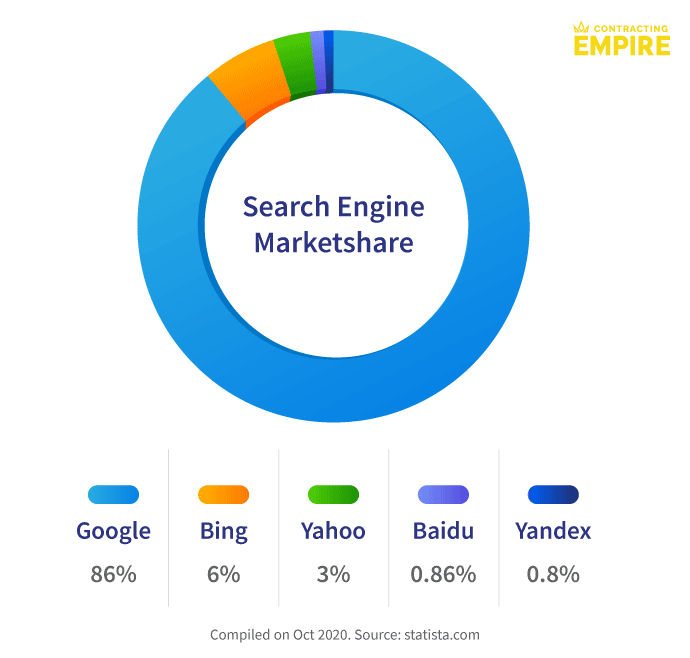
It has a world-wide market share of 86%. Bing has 6%, Yahoo 3%, Baidu (Chinese search engine) 0.83%, and Yandex (Russian search engine) 0.8%.
Although Bing has its ups and downs, we can see that Google is the dominant search engine. That’s why we’re focusing most of our efforts to optimize the experience for the customer through the eyes of Google.
This will work for all other search engines as well as they’re playing catch-up. Because you’re building your Know, Like and Trust, you’re not only doing this for search engines.
When people are looking for a solution online, they go deep. They do a lot of research before reaching out to the person they believe is the right fit.
When they’ll get on the phone with you, your sales process gets much easier. They’re already pre-prepared and they’ll have a lot of their questions answered already by your website. Even without you interacting with them beforehand.
Lets break this down.
The real truth is that you don't need SEO for your contracting business.
You actually need happy customers, right? This is the actual outcome you’re shooting for. More about that in this article on systems thinking for contractors.
You need customers for your contracting business. No business can work without customers. SEO is the leverage you can use that will always bring customers through the door – consistently.
But again, we’re not talking about SEO for you as a contractor. We’re talking about the customer experience you’re creating.
We are not optimizing for search engines. We’re optimizing for people.
We create an experience for the people. So more people come and visit your website. More come and take advantage of your services, so that more people can refer more people to your services.
It’s like a flywheel. It’s a circular system. It should always evolve slowly but surely. You upgrade node A in your business, you get a little boost. You improve node B in your business, you get a little boost. You scale node C, you get a little boost.
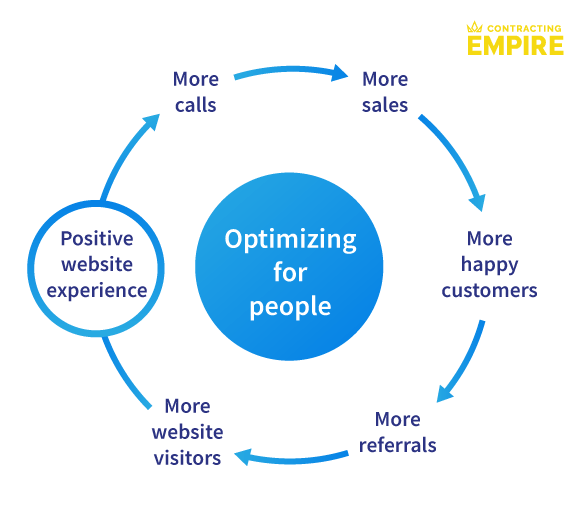
To do that, you’ll create an online environment where subsystems can only thrive. Then you’ll increase the traffic. After that, you’ll start increasing the conversions.
All while qualifying the price-shoppers and keeping the people you actually want to serve. From there you’ll transform your customers into raving fans that will refer qualified people your way.
What else can you do that’s going to increase conversions?
Well, you can create some videos so people can see you and relate to you. By seeing you, you can build trust through your posture and the way you speak.
After that, you can put out more content that solves questions. Make people understand that you’re an authority in the market.
You can also increase the number of reviews your business has.
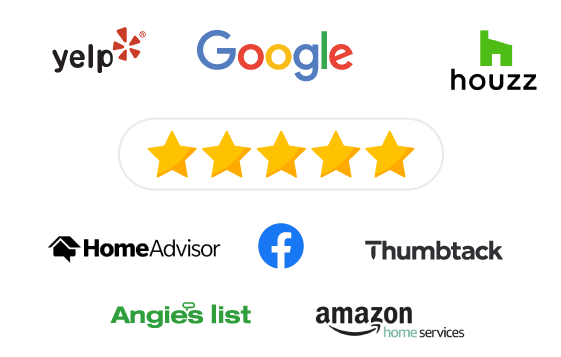
All these different things that you can do have a compounding effect. It’s much more than SEO. It’s actually integrated inbound marketing.
Inbound marketing attracts customers by serving valuable content to them. It offers a tailored experience to them. Its purpose is to create connections with your users. Whoever searches for you online is going to be much more pre-determined to want your service. We’ll call them a warm audience.
In contrast, when you’re interrupting someone with your ad on Facebook… while they scroll their newsfeed, is called outbound marketing.
These people aren’t necessarily looking for your solution (and sometimes don’t even know they have a problem). It’s what marketers call a cold audience.
Attracts customers by adding value
- Customer oriented
- Creates connections
- Builds a warm audience with genuine interaction
Interrupts prospects without their permission
- Money oriented
- Feels spammy
- Reaches a cold audience that isn't interested in interacting
The way ads work is that you put some money in a platform that can provide the eyeballs. They show your ad. But you may or may not have success. It depends on how well you set up that campaign. And how much money you invest daily in those ads.
This will never happen with good content.
The value of SEO in your contracting business
Together with your website, SEO plays the role of an online salesman. A team player that helps your salespeople cut their effort & time spent on pre-qualifying in half.

You're building a sales rep that's available 24/7.
Because content never sleeps. Content is always there.
Once you create quality content (not just content for the sake of SEO), it does the work for you. You’ll have a complete system that never sleeps. Unlike ads, it works even when you stop putting your time or money into it.
Instead of trying to explain the same thing over and over again when somebody sends an inquiry… you cay forward them to an article on your website to answer that question for them.
When their questions are answered, the client is already primed for your advice. You can now continue the conversation with high chances of closing the sale. They already know that you’re the best choice for them.
That’s why there’s huge value in making your website rank online.
How fast will your results be visible?
It’s very common for people to expect overnight miracles. What I usually tell my clients is to wait at least a month since an article is published to check for feedback.
From our experience, an article can take from a few days to a few months to be indexed. It all depends on Google “spiders”.
The Google search engine works by crawling through all the websites online. Taking content signals and putting them in a database. When people do a search on Google, it shows the most relevant information. All based on the information the robots collected.
You can request a manual crawl from Google to index you faster. But that doesn’t mean that your website is going to be seen in the first positions right out of the block.
Google is going to test your website by placing your listing in the first few entries and see if people click on it. If it’s interesting enough and people do click on it, it will rank faster.
What I advise my customers is to go with a six months contract. In six months, we push out at least 18 pieces of content. Based on that we’ll start having a clear picture of what’s working.
Here’s a graphic for an article we published for one of our clients. The article was published on June 25th 2020.
The first impression came on the 3rd of June. From that date, both the impressions and clicks steadily grew and continue to grow to this date. Without anyone touching the article. It’s all organic growth. And it’s all compounding.
Usually, all the articles you publish are going to follow the 80/20 rule. This means that 20% of your articles are gonna bring in 80% of the traffic.
Some of the articles will work very very well. Some may flop completely.
We can teach you how to debug this and see exactly why some pages and some content is performing better or worse than the other ones.
To answer the question of how fast will the results be visible… they could be visible in a month.
Because there are billions of websites online, it takes time for Google to tell which content is more valuable. It does that by testing the user experience with that content. There are approximately 1.8 billion websites online right now, with less than 200 million being active.
That’s quite a lot of content for search engines to find, test, and index. The algorithms need to crawl every website. That’s why it doesn’t happen in an instant.
I recommend waiting at least six months while pushing out content, to see a complete picture of how it starts working and performing.
Stopping SEO too early is an expensive mistake
Several years back, I had a website selling wedding invitations. I invested heavily in SEO, pushing out articles and all the good stuff for about a year. I was so caught up in the business itself that I made a rookie mistake…
I didn’t measure anything. I didn’t look at the data to see what was going on.
Wedding invitations are a highly competitive niche. There are websites that are spending hundreds of thousands of dollars each month on ads. It is a very competitive market to enter.
The funny thing was that after one year we were able to penetrate the market and started getting quite a lot of visitors.
But that wasn’t enough for me.
I got emotional. I didn’t check the data. I scoffed and said that it doesn’t work. I got “creative” and changed the whole system.
That was a very expensive lesson. At that stage, we had about 300 new customers each month and the number was slowly decreasing.…
I didn’t study causation and correlation. I didn’t give this process enough time.

Your traffic is not going to peak instantly. Sometimes you’ll experience linear growth. Sometimes the growth is exponential.
And sometimes it grows very very slowly and then starts to peak after a certain period. We’ve seen all these scenarios but the general rule of thumb is that it always grows.
It takes anywhere from a month to a year to start understanding the results. So whenever you put out content using my method, it is going to work.
It’s always going to be better than not doing anything. And it gets better and better the more you do it.
Should you completely change your website before doing SEO for your contracting biz?
When doing SEO, the first thing I do is a technical audit. Does your website need any improvement or not? Is it loading slowly? Are there any technical errors? Are pages getting indexed correctly? Is the site mobile friendly?
For contractors, I prefer using WordPress websites. 60.4% of all sites online are built on WordPress. And this number is only growing. Huge websites like Techcrunch, The New Yorker, Beyonce have WordPress as their backend. And they are working seamlessly.
WordPress has been available for a long time. And it’s here to stay. Even though it’s still written in PHP it performs very well for what it needs to do. And it gives you full flexibility to add new pages and content with ease.
When I take on a contractor SEO project, the first thing I do is identify any quick wins that I can get you on your website. Start improving on things immediately.
Sometimes it’s hopeless. The website is not maintained. It’s riddled with so many bugs that it’s easier to redo the whole website, fully optimized. On a good hosting provider.
Understanding how search engines work
Since Google’s start, a lot of people have been trying to game the system. The hope was that by understanding how the algorithm works, they can make their websites rank higher.
Because marketers were always trying to game the system, Google always had to be on top of things. Update its algorithms. Stop these ill-intent people from flooding users with content they don’t want to see.

Customer experience is what Google is looking for. Google is making money by selling ads. And by selling ads it can sustain the whole system.
So it’s in Google’s best interest to offer a seamless experience to the user. When the user is searching Google, they get what they’re looking for.
Simple, right?
There are four big stages that Google transitioned throughout. These hold the key in understanding what it wants from its content creators, users, and advertisers.
In the first phase, the whole ranking brain of Google was that a webpage or website was worth more if other websites or pages were pointing to it.
If more websites considered it appropriate to link back to your website, it meant your website had share-worthy content.
For example, if website A had 10 links pointing to it and website B had 11 links pointing to it (on the same subject), the second website would appear higher in the search results.
When marketers figured this out, they started creating all sorts of click farms. Systems that would create these fake links that were pointing back to the articles they were trying to promote. Because all they needed was an extra link, it was easy to game Google’s search algorithm and rank their websites.
When Google caught onto this, it started introducing page rank and on-page optimization. This means they started looking more closely at things. At the quality of the websites that were linking back to the other websites.
It tried to assign a weight to every link that was pointing out to a website.
For example, 11 links could have lesser weight than 1 link coming from a high-authority website that people find useful.
In phase 3, Google started using all sorts of animal names to name their algorithm updates (like Panda, Penguin, Hummingbird, and so forth).
With these updates, Google started to understand the search intent behind a search. They also started using AI to figure out what the page content is about and what people were actually looking for.
In phase 4, as mobile traffic was gaining steady ground, updates focused on mobile searchability. Usually, 50% of a website’s traffic is coming from a mobile device so it was a logical move.
At the same time, they introduced updates that tried to make the user experience even better.
For example, in the Fred update, they started penalizing websites that prioritized monetization over use experience.
So if you had low user engagement and your landing page was geared towards creating conversions, Google would know.
If your website brought no value to the end-user & you were set on selling… Google would pick up on that and move you lower in search rankings.
How does Google know who’s been “naughty” and who’s been “nice”?
As Google started to gain more market share, it owns a lot of tools. Tools that can measure user interaction on websites.
For example, tools like Google Analytics have direct access to how much time users spend on your website. What pages they visit, what’s their intent, and their user flow. The information on how a user behaves on your website is then correlated with anything else that the user does online.
You probably use Google Chrome as your browser. You probably also use Gmail. Then you need a document from time to time – so you go to Google Docs or Google Spreadsheets. Need directions? Google Maps is there to save the day.
You’re using Google’s very tightly-knitted ecosystem. This ecosystem blends everything together to understand users better.

But why would Google even bother with users’ wellbeing?
Well…
Don’t get fooled by this noble mission of connecting the world.
The Search Engine User Experience
A deep understanding of a user’s intent and their flow creates a clear picture of how valuable a user is. Once they know as much as possible about the user, they can serve specific ads to them.
So the whole purpose of Google is to make money. The way they make money is by creating an impeccable user experience.
By creating an impeccable user experience, they can serve relevant ads to the user.
Serving specific and relevant ads increases the chances of a sale happening from the users’ end. The advertiser is happy to sell their product or service. The user is happy with their purchase and search experience.
Easy peasy.
Now that we understand the intent behind why Google does what it does, let’s take a look at how it actually does that.
In the diagram above, in one corner we have Google as a search engine. The purpose of the search engine is to give users relevant search results.
The second part is the user that’s looking for solutions & answers.
The third and final part is the content creators. People that are looking for users.
Although each of the three parts is separate, all of them “talk” to one another. They’re interconnected.
Here’s the dynamic:
Content creators care about users. They’re looking to grab more users that would read the content. For example, you as a contractor and a content creator is looking for people that are searching for your services.
At the same time, content creators care about Google. You’re looking to please Google so you show up in the search results.
Now, Google cares about the user. They want to create a user experience that’s so good that it keeps users online more. The more time users spend online on their services, the more money they make.
Google also cares about content creators. It wants you, the content creator, to make quality content so the search engine can leverage that and offer value to the users onto its platform.
Users care for a simple & fast experience from the search engine. At the same time, users want to find a solution to their problem (offered by the content creators).
This whole machine is run by the advertisers. So in the middle of the scheme, we have people that put money into ads.
Google would not be able to employ the hundreds of thousands of people it employs if they would not be making revenue.
Users would not be using Google because Google would not exist without revenue.
Content creators would not fight with anyone or anything if the search engine wouldn’t exist. Or they couldn’t make money. There would be no point in creating content online.
The whole system is fueled by money.
The good thing is this: in the end, everyone is either making money or solving their problem.
Understanding how customers think
When users search for something online, there are two ways they do that.
In the first scenario, they are looking for a solution that someone can provide for them. So they’ll type in a solution-focused search, such as “sidewalk repair near me”.
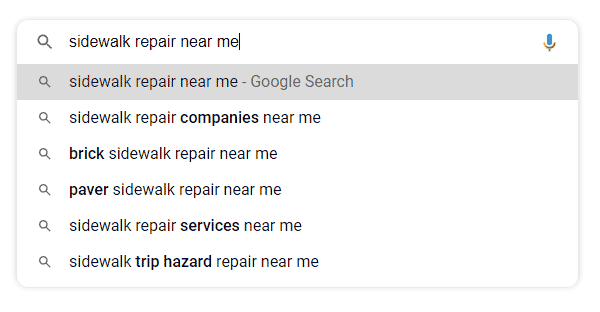
In the second scenario, they want to fix the problem themselves. So they’ll type in a question.
Questions like “how”, “why”, “what”, “when”, “where” or words like “tips”, “X ways to” create problem-focused searches. Eg. “how to fix cracks in my sidewalk”, “when should I remodel my kitchen”, “10 ways to fix a leaking pipe” etc.

The beauty is that you can create content and answer these questions. Answer in a way that makes your business stand out and builds trust.
You build authority for your business online.
Sometimes, instead of trying to fix the driveway by themselves, they’ll contact you. Because it’s much easier if you fix the problem for them.
This is exactly what SEO helps you with in your contracting business. Answer questions, present opportunities.
Bridging the gap from “Do It Yourself” to “Done For You”
When people try to fix home issues themselves, they’ll perform worse than you. They don’t have your tools, your experience, and materials.
So whatever they’ll get from Home Depot and try & fix by themselves is usually not going to last.
With each article you write, you educate your potential customers. By helping them, you’re helping yourself.
Eduard Boka
With any article you write, you get the chance to educate your potential customers. This may translate into a sale down the road.
Let’s say you write an article about fixing damaged driveways. Here’s where you can talk about the pros and cons of them trying to fix a problem by themselves.
For example, one of the pros is that (at first!) a DIY job seems cheaper.
“It’s not a big deal, I’ll just do it myself.” – a courageous prospect
But at a closer look, the cons overweigh the pros.
In order for a homeowner to fix a damaged driveway, they’ll have to spend time researching the issue. Then, they’ll need to leave home and drive the car to the shop. The car uses gas which costs money. They spend 2 hours in the shop trying to find the best materials and tools. By the time they get home, it’s already late in the evening and the day is gone without much accomplishment.
The next day, week, or whenever he could make time for it, our handy homeowner will start the apparently simple job of fixing his broken driveway.
After three afternoons, things didn’t exactly go according to plan. But although it looks kinda messy, they repair the driveway.
They won’t have to think of it ever again… until the next winter when the thing is going to crack again…
And they’ll be right where they started in the first place, while also losing money and time.
You can incorporate this into your SEO by writing relevant articles. And you’re not scammy for doing this. You’re telling the truth. But your potential client doesn’t know that. That’s why it’s important to educate your audience.
This is how you can bridge the gap between a problem-focused search and a solution-focused search. You give users what they’re looking for and position yourself as the solution they actually need.
Perhaps they will not become a customer right away…
Let’s say you’re doing ponds. You write an article about pond maintenance and repair. The reader has a small pond, reads your pond-repair article, and finds it useful. You’ve planted the seed.
When they’ll plan on upgrading their pond, they’ll think of you. If you’re providing relevant information, you’re the one they’re going to remember.
Don’t discount the time it takes for one person to actually become a customer.
The work you publish online is always going to be online. And content never sleeps.
Eduard Boka
If you do a great job and explain what you do right, in the end, it’s going to create that Know, Like, and Trust.
Which will give you a steady stream of visitors.
Because Google’s desire is to show the most relevant content.
By creating relevant content, you’re creating a complete experience. You complete the user experience trifecta.
Everyone is happy. The system is circular and self-sustainable.
And the best thing is that once you create quality content, it’s there to stay.
Read on…
Content Never Sleeps
Think of your website is your 24/7 sales rep that’s always working for you.
The money that you invest in your website will always provide a return on investment.
If you would hire an actual sales rep, you would still have to train them. Pay them monthly. Lead them.
The biggest difference between this virtual sales rep and the actual person is that the online one…
- Doesn’t get sick
- Doesn’t need paid leave
- Doesn’t complain about how much you pay him
- Doesn't even eat...
- Comes to work even over the weekends and holidays
- Doesn’t have a kid / wife / aunt / great-grandma that needs urgent attention
- Serves all customers with the same level of excitement as on the first day on the job.
Let’s train him & teach him how to lead.
What to write about so your website gets qualified leads
This is a problem that many people from many industries I’ve worked with experience. People don’t know what to write about.

Here’s the thing… You’re always sitting on a pile of gold. And you don’t even know it.
This wealth of information comes from all the interactions you’re already having. Sales calls with your prospects (assuming you have a running business and you have customers).
So you may want to think back to all the interactions you had with your prospects. From start to finish – through the whole contracting process. That is going to create a huge database of information that you can build on.
There are two scenarios:
- Scenario 1: You already have a contracting business and some customers. So you have this wealth of information I was mentioning and can use it.
- Scenario 2: You have no customers.
We’re going to tackle both.
Scenario 1. You have a running business and customers
As mentioned, you can access this pile of gold by examining your interactions. What you do with a prospect throughout the whole buying process.
Gold nugget #1: Questions people ask you
For example, you can write articles that answer the questions people ask of you when you’re on the call with them.
Other articles could address all the questions people have when you go for the in-house consultation.
For other articles, you can answer the questions from the final walk-in or project handover.
For example – after an in-house consultation, you can send the client an email with an article. Information that addresses all the questions they had during the visit.
This shows them you really care about them, and you’re not only trying to make a sale.
Here’s a quick example:
Hello Mrs. Peterson,
We met a few days ago and I gave you a quote for your kitchen remodeling project.
You had a few questions about our process and the materials we use. To help answer your questions I’ve attached an article / a short video / resource that explains everything from start to finish.
Please go through it when you get a chance – I know it’ll help.
I’ll give you a call tomorrow to discuss the information in detail.
Sincerely,
John
The information you put into these posts weighs much more than other topics. You can build the meat of your service pages based on these questions & answers as well as a solid “our process” page.
That’s how you use these recurring questions from your sales process to make your job much easier. You’ll get higher qualified prospects that already Know, Like, and Trust you.
Gold nugget #2: Good things people say about you
If your clients love particular things you do, talk about it. For example, if your work is tidy and you clean up after yourself. Take this information and write a whole article that highlights the benefits of hiring you.

In 1917 Lucky Strike debuted the slogan “It’s Toasted”.
The thing is that all other cigarette brands were toasting their tobacco. They were the only ones that highlighted this and won big time.
For context, you can watch a video of the reenactment on the show, Mad Men, by clicking this link.
If your clients noticed that you’re a good listener, take advantage of this, and transform it into your mission. Write an article that explains this.
Why do your listening skills and people skills make you better than your competitors? And how this is useful for your client?
Gold nugget #3: Problems people complain about
Reviews are the best ways to identify what problems customers encounter. Examine your reviews or your competitors’ reviews and scan for things people complain about.
Identify problems they’re having and then write articles that reduce this pain.
Why online reviews are a gold mine
One of my favorite things to do is to go to reviews and see what people are saying about that specific service. In our case, it’s kitchen remodeling.
I type in “kitchen remodeling Nashville” on Google and then I go to Google maps. This will give me a whole list of companies that are listed to provide that service in Nashville.
You can also use Angie’s List, Yelp, or other sites that have reviews. You’ll see what people are writing about other Nashville kitchen remodeling companies.
Choose a company from the list and check their reviews. First, you will want to go for the 1, 2, or 3 stars reviews. These will highlight the customer’s pain about the service. You can take valuable notes from this.

From the review above, we learn that this customer expected the company to be organized. Be on time, and consult them before making any decision about their house.
The 5 and 4 stars reviews are all nice and happy, and they won’t give you much insight into the customers’ pain.
What they give you are things customers find valuable. You can use this information later to write your content.

Now, go to the next company and read more reviews.
Take notes of what you find useful and create 3 lists with this information.
Your list should include people’s pains, desires, objections, and expectations on the service you provide.
In the end, you’ll have a database you can use to create articles. These will answer questions, offer solutions, and speak to your customers using their language.
The more you dive into these reviews, the more relevant information you’ll get.
In the end, you’ll understand all of your future customer’s fears, thoughts & problems.
Using solution-focused searches and problem-focused searches as starting points
Another way to get ideas for articles is to take a look at the searches that are already happening on Google. If we choose kitchen remodeling as a topic, a solution-focused search would look like this:
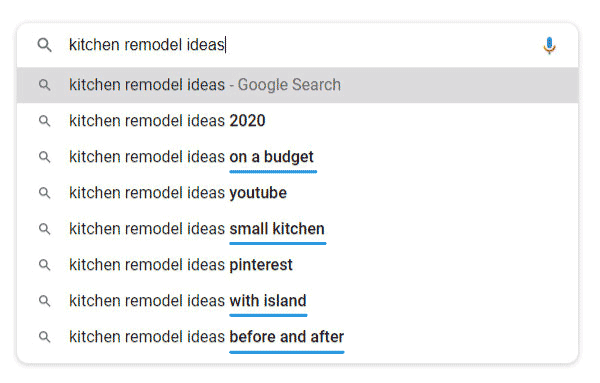
You could write 5 articles based on that query alone.
Another way you can explore localized solution-focused searches is by adding the location to your search term.
For example “best kitchen cabinets in Nashville”. Now you can write an article that recommends the top 10 kitchen cabinets companies on Google.
Also, you can make use of Google reviews again. Type in “Best kitchen cabinets in Nashville” and select a handful of companies that have excellent reviews.
You can call that article “10 best kitchen cabinets in Nashville and where to find them”. When you, as a kitchen remodeler, recommend kitchen cabinet companies, and people read your article… who do you think they’ll hire to remodel their kitchen?
That’s right! Your company.
With an article like this, you create authority. People will trust that you, as a kitchen remodeler, know who’s the best cabinet company in town.
The same goes for problem-focused searches, that can look like this:

You have 6 potential article subjects that people are actually interested in.
But here’s what’s even better.
How to master your targeting
If you really want to make a valuable article that drives in qualified traffic… you should go as specific as possible.
If you’re doing kitchen remodeling repair in Tennessee, your article title should include one of the locations served. Eg. “kitchen remodeling in Tennessee” or whatever state you want to rank for.
If you’re doing this job in Tennessee, you wouldn’t want people from New York to reach out to you, right? You won’t travel that long for a job and you’ll be forced to turn people down. Which is not something that helps your business.
You want clients to find you in the area you’re actually serving.
The more narrow and targeted you go in the query, the more qualified leads you’ll get.
You will need to decide if you go with a broader targeting or a granular one.
If you go very targeted, the keyword difficulty will be much smaller. This gives you higher chances of ranking faster, with shorter articles.
For example, instead of targeting the whole state of Tennessee, you can target specific cities in that state. So your article title could be called “kitchen remodeling in Nashville” or “kitchen remodeling in Franklin”.
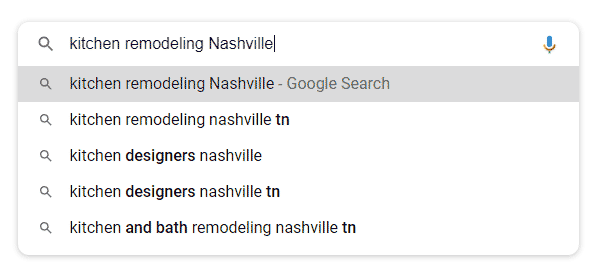
Let’s see what you can do to get some insight into any industry, even if you don’t have a contracting empire yet.
You can leverage the techniques in scenario 2 even if you have a successful business.
Scenario 2. Using free tools to give you insight even if you don’t have customers yet
One of the best free tools out there is UberSuggest.
At Contracting Empire, we use paid tools that allow us to dig deeper into insights. But some of the free tools do their job very well.
If you search for “kitchen remodeling Nashville”, Ubersuggest will tell you:
- what’s the estimated monthly search volume
- how easy or hard it is to rank for that specific keyword or term
- how much it costs to advertise for that keyword
- a list of related keyword suggestions
- a list of the first place ranking pages
You can make a list of all the keywords that interest you, compile the data and get a clear picture of your opportunity.

You’ll also see sites that are currently ranking for those search terms.
You can get ahead of these competitors if your articles match the users’ search intent better.
So what you’re looking for is to do what your competitors are doing, but do it better. Google is going to pick up that your content is valuable and much more relevant. It’s going to put you among the first search results.
In the end, this will lead to more people knowing about your service, and more people hiring you.
Analyze your competition
Also on UberSuggest, you can search for your competitors’ website. See what keywords they’re ranking for already and what position they’re on.
Using free tools like this will give you a clear picture of the industry. Also a bunch of keyword ideas for writing content.
Suggestions based on Latent Semantic Indexing (LSI) Keywords
There’s this myth in the SEO world that you can use words that have a similar meaning to game the system. Or words that have similar contexts, that are not exactly synonyms.
So if you’re talking about “kitchen remodeling contractors”, LSI words could be kitchen cabinets, kitchen tiles, tabletop, kitchen stool, work belt, and ladder.
Although as proven by us that specific tactics don’t work and don’t matter as long as they don’t serve the end-user, we can still leverage LSI tools for inspiration.
There’s a great article by ahrefs, the industry-leading SEO tool that dives deeper into why LSI keywords alone don’t do much.
But, to get great keyword ideas, there are a few free tools that do a great job. Tools that help us understand search-intent and what people are looking for.
A great free tool you can use is LSIGraph. The data it displays is like Ubersuggest but there may be a few extra gold nuggets in there.
Another tool you can use for inspiration is Keyword Tool. It doesn’t dive deep into the results unless you go premium. It will return a huge list of keywords that you can look at and sort through though.

You can then take those keywords and plug them into UberSuggest or LSIGraph. Now you can assess the potential of writing on that topic.
Take advantage of free tools provided by Google
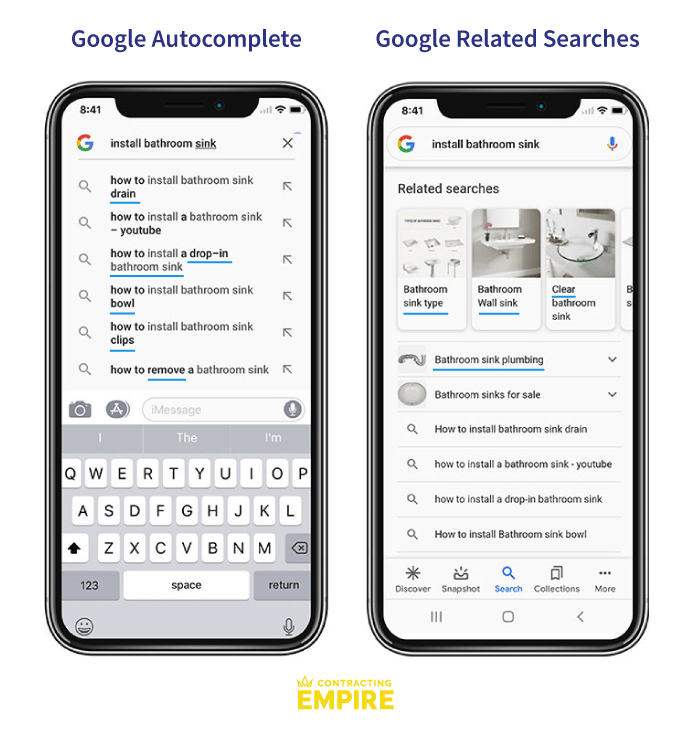
The type-ahead feature (or autocomplete) and the related search feature are especially helpful for problem-solving searches.
If we type in “install bathroom sink” we’ll get a lot of very specific suggestions for what people are looking for. A set of suggestions is going to appear directly underneath the search box and another list at the bottom of the search results page.
You can write articles on all these terms and ease the customers’ pain. Of course, you can also do a video on how you install a bathroom sink drain.
All you need to do is record yourself or your team while on a job using your iPhone in landscape mode. Explain the whole process.
Although this sounds a bit counterintuitive, trust me it’s not.
People are always looking for convenience.
So when they’re going to see the process, what it actually implies, and how professional you are – they’re not going to want to do it themselves. They’re going to go with your services.
And even if they don’t call immediately, because they watched your video… they might still recommend your service to other people.

How to write a customer-oriented article
When you’re writing your article, shoot for a conversational style. Just like talking to your customer, face to face. Guiding them through the process so they can solve their problem. Or look at you as an expert that can solve the problem for them.
One of the most asked questions I hear all the time concerns the length of the article.
How long should your article be?
As always, it depends.
Usually to figure out the input of a process you need to take a look at the desired output. We’ll be exploring 2 approaches:
– a customer-oriented approach
– one that is more towards “gaming” the system by leveraging what the competition is doing.
The customer-oriented approach
In this scenario, we’re focusing on answering the searched topic as completely as possible. Take each topic, either solution-focused or problem-focused, and answer it.
The more clear and to the point, the better.
Search-engine oriented approach
The assumption here is that the search engine will rank the article that seems to be the most competent and thorough on the subject.
To determine the length of your article in this case, search for your target keyword/phrase on Google. Open the first 10 results (non-ad ones) and see which ranks higher and why.
What are they doing well? You should also start seeing a trend.
For example – if 8 out of 10 competitor pages are displaying a picture gallery for the searched topic… it means you can focus on a picture gallery as well.
You can also “zag” when others “zig” and test that out and see how your article performs. So make a comprehensive article infused with images instead of a picture gallery.
Usually, the best outcome revolves around combining the two approaches.
Not too short that Google ignores it, but without overdoing it in a way that it doesn’t serve the customer anymore.
As a rule of thumb, you should shoot for at least 500 words per article.
10 things you can do to make your article more engaging and interesting
1. Increase readability
When writing content, readability is one of the main things you should focus on. Make sure that your content isn’t making the eyes of your readers go through a marathon.
For example – medium.com one of the most popular online publishing platforms displays its content in a narrow container(680px). They also use a large font size (21px).
I’m assuming that after thousands of tests they came up with the sizes that cause the least strain on the eyes. While also keeping readability high.
The outcome is that their users spend more time on the platform and read more content.
2. Write shorter paragraphs
You should break long paragraphs into multiple paragraphs.
Make it easy for the eyes to read through the content.
3. Create a visual hierarchy

Make sure that your content has a visual hierarchy.
Make it easy for the visitor to understand the context and what topics the paragraphs belong to. This makes it easier for them to skim through the content and give them the option to go deeper into it.
4. Use images
Your content should be interwoven with images. These should support or reflect what you’re writing about in the article.
Images have the ability not only to create more attention but they also break content in a way that’s easier to digest.
5. Use lists and bullet points
Add some bullet points to list some pros and cons or just create a list of things. It makes the content more engaging and more interesting.
6. Inject trust and authority in your articles
Give examples of jobs that you’ve already worked on. What was the challenge and how you were able to solve it and how you can do it for your potential customer as well?
People love a good story. And a hero.

7. Add some testimonials
Sprinkle in testimonials specific to the topic as a little intermission through the content. This showcases that you’re a pro and know what you’re doing.
8. Sprinkle in a video or two
You can boost engagement and time spent on your article by embedding a video.
This video can be about:
- you talking about the topic
- it could showcase a job – walkthrough/challenge/solution you implemented
- a customer testimonial
- a story from a job you did
- things they should avoid when going for a service like yours
- a solution on how to fix something quickly by themselves
The list is virtually endless for videos that can support your content.
They’ll spend more time on your website. In the meantime they’ll get primed even more for the future conversation you’ll be having with them.
9. Link between references
Make sure your content supports itself.
So if you can reference another article from your article this will serve your potential customers even more.
10. Make your article share-worthy
If possible make it share-worthy.
For example, if you’re a contractor that does roof cleaning & one of your services is gutter cleaning – you could write a guide on how to clean your gutters.
Seems counterintuitive BUT you can present the option of them doing it by themselves. With pros and cons as well as the pros and cons of hiring someone to do it for them.
Ladders, safety – they could break a bone, the mess they have to deal with… there are many reasons not to do it by themselves.
Perhaps they’ll even try to do it themselves and fail.
You can make more money down the line if you focus on injecting preeminence into your marketing.
Here’s the list again for a quick reference:
- Focus on readability. Narrow reading width and big font size;
- Break long paragraphs into shorter ones;
- Create a visual hierarchy of your content;
- Add images to break up content and spice things up;
- Add some bullet points;
- Add a story of how you solved a problem on a previous job;
- Add in some testimonials that support the article;
- If possible, add videos to your article;
- Link to other articles on your site;
- Make it share-worthy.
Measuring & improving your SEO
One of the most important things that you should do in your marketing is to track what you’re doing.
This is completely irrelevant if you can’t read the data and aren’t sure what you’re looking at.
Equally important is understanding the rules that govern your marketing system. What are the interactions with your business systems as a whole?
There’s a great distinction in marketing. Contenders are the usual linear thinking where you improve one thing that leads to the improvement of the whole.
The other is systems thinking. Here everything is governed by circularity and all actions are interconnected.
The thing you should be measuring is the total growth of your business. Work on gradually improving parts of your business system. Parts that are interconnected. And grow them in tandem.
That’s why SEO (and inbound marketing) has such an important role in your contracting business.
It triggers a lot of nodes in your marketing system:
- It builds a connection with the user;
- It solves their problems while building know, like, & trust;
- It transforms normal leads into qualified leads;
- It decreases acquisition costs by 57% compared to outbound leads (HubSpot);
- It increases your exposure in search engines, making it possible for users to discover your business and your services;
- It makes sales a breeze;
- It boosts the economics of your business;
- It never sleeps.
I have yet to find a marketing subsystem more powerful. Something that you can plug into your business so fast and with such long-term impact.
At the same time, there’s a caveat.
SEO like any system or subsystem follows the Pareto Principle or the 80/20 rule.
This axiom states that 80% of outcomes are a result of 20% of inputs for any given event. The goal of the 80/20 rule is to identify which actions are most productive so you can make them a priority.
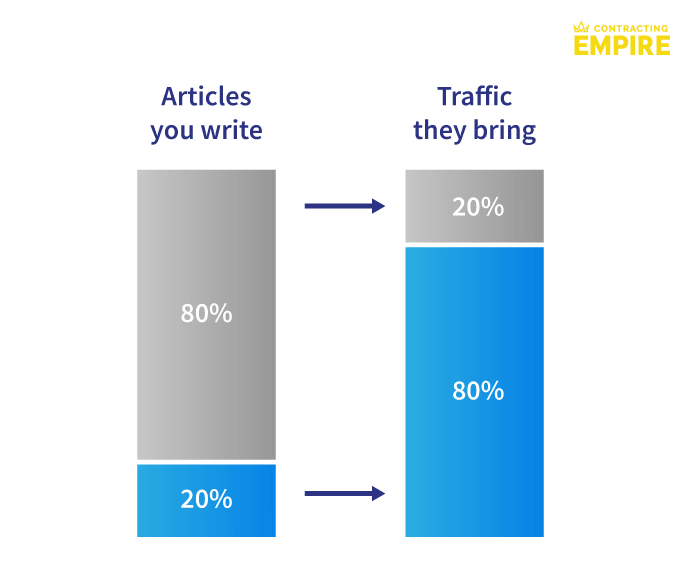
So don’t get discouraged about the fact that NOT all your articles are going to be a success.
That’s OK.
20% of the articles will still bring in 80% of your total traffic. We’ve proven and experienced it over and over again.
Below is a chart for two completely different websites that are doing inbound marketing.
The red one is a contracting website with around 100 content pages, while the blue one is a big agency with over 4000 articles.

We can quickly see that about 20% of the articles bring in the meat of the traffic to the websites.
With 5% of the pages ranking really well.
In the case of the contracting site that is 5 pages out of 100 and for the agency, it’s 200 pages out of 4000.
There are three quick notes to take from this:
- The more content you create, the higher probability of having a page in the top 5% of traffic drivers;
- More traffic > no traffic;
- It’s easy to get discouraged.
That’s why most people stop – because they don’t understand what you’ve just experienced.
They completely miss the depth and impact it has on the system as a whole.
1. Building that trust, credibility, and authority online.
2. Simplifying the sales processes.
3. Making the customers choose you.
Alright, now that is out of the way let’s see what you should track.
Make sure you look at the system as a whole and don’t get emotional about it or make abrupt decisions.

1. Traffic
You can use a free tool like Google Analytics to track what’s going on with the visitors to your website.
You should set some clear goals to determine which articles are the driving force behind your website.
How do people interact with your content?
Attribution one great variable to track traffic. This is the place where the customer came in and later became a client.
This will give you a deeper understanding of all interactions needed for them to reach your end goal.
Analytics just got a major update that unlocks attribution and other insights & predictions for the casual user. You can read more about it in this article.
2. Conversions
Another metric that marketers rarely talk about – but has a lot of insight is behavioural data.
You can use a free tool like HotJar to record the user’s interaction with the website. See exactly how they browse through the website and where they stop.
To see exactly which page is performing best and why you can use a free tool like Google Search Console.
This will enable you to see all the queries that users used to get to a certain page on your website.
3. Economics
By tracking your goals and conversions and fine-tuning your pages, your output should be a direct increase in sales.
SEO is an investment like any other in your contracting business.
It’s like training a sales representative. The more you teach it to do, the more it’s going to deliver. The more objections it knows to handle, the better the outcome.
You get it.
When you also take a customer into consideration, take into account that a customer isn’t only ONE transaction.
If you win them over they’ll be able to refer new customers your way. Perhaps you’ll also be able to serve them with another service down the road too.
Your customers are your biggest asset to bringing in NEW qualified leads.
Eduard Boka

So even if you made a profit of $10k with that kitchen remodeling job, they brought in another customer worth $10k.
Suddenly the life-time value of that customer is $20k.
Perhaps they decide later down the road that they want to upgrade their bathroom and you offer that service.
Another $5k in profit.
This is the principle on which insurance companies work. They can afford to spend $5000 to get a customer because if that customer stays with them for 2 years they break even on commissions.
If they stay for 20, the insurance company makes $90k. Now multiply that with 1,000,000 customers. Not too shabby if you look at the whole picture.
From my experience, doing SEO as a contractor (or any other online business) is a long term investment strategy.
A gift that keeps on giving.
For example in one of our client projects we were able to double the number of quote requests which in turn led to sales having more opportunities.
They were able to land 20 extra customers each month consistently. With a customer lifetime value of around $3300, that’s an extra $66k extra per month. For a $3k/mo investment.
It’s true, they invested $21k for 7 months without seeing impressive results.
It took some time to reach a tipping point. The critical mass needed to have at least 4 articles out of 20 that work and bring in some serious traffic.
But for the next 5 months, they are bringing in an extra $66k/mo.
That’s an extra $330k that will only keep on growing as more articles become indexed.
Plus we fine-tune the articles constantly to accommodate users better and offer a better experience.
So would you spend $36k per year and make $330k?
I surely would.
That’s the reason I’ve started writing content as soon as I had a clear vision and strategy for Contracting Empire. I love to practice what I preach.
Jack Born created the concept of the Power Triangle which brings these 3 pieces together.
The power triangle is more of a subsystem (because it’s circular & interconnected) than a tactic – as he calls it.
Below you can see a video of Perry Marshall presenting how traffic, conversions, and economics work together. As a circular and fractal system that follows the 80/20 rule.
Wrapping up
Phew!
You’ve covered a lot of ground and you should have a level of expertise that far exceeds that of your regular contractor.
You can start working on some magic for your business right away.
If you’d like to take advantage of my user-experience infused expertise directly… have me & my team work on SEO for your contracting business, click the button below.

Article by Eduard Boka published on November 2020
An entrepreneur since 2004, I eat marketing for breakfast, lunch, and dinner.
My biggest skill is transforming my expertise (from working with big businesses, and huge projects) into an applicable form for contractors.
Helping them win big, fast, and long-term.

